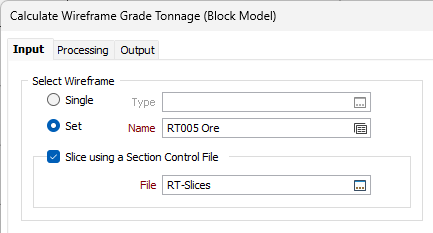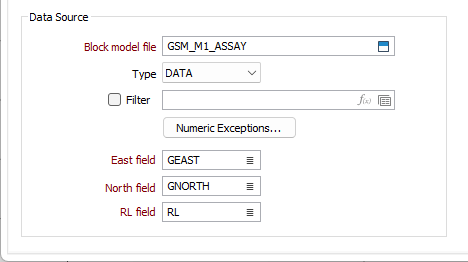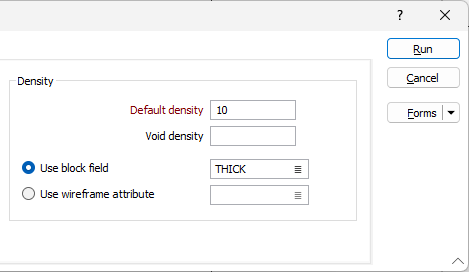Calculate Wireframe Grade Tonnage (Block Model)
![]()
A Block Model Calculation is used to calculate estimates. Each block value is weighted according to the volume of the block that is inside the wireframe.
If the block lies completely inside the wireframe, then a simple calculation, using the block dimensions, takes place.
If the block intersects the wireframe, a Boolean calculation determines the exact volume of the portion inside the wireframe. This is done automatically.
Select Wireframe
To process a single wireframe, select the Single option, select the Type of the wireframe, and then the Name of a wireframe of that type.
To process multiple wireframes, expressions, wildcards and partial names may be used in the Name field to select multiple wireframes as an adhoc wireframe set. A right-click Preview option will perform a check of an expression before using that expression to generate an updated list of wireframes. Alternatively, you can click the Expression icon ![]() and use the Expression Editor to create, modify and validate the expression. When a name or wildcard is entered in the Name field, and the Expression button is selected, the name/wildcard will automatically be converted to a valid expression when opened in the editor.
and use the Expression Editor to create, modify and validate the expression. When a name or wildcard is entered in the Name field, and the Expression button is selected, the name/wildcard will automatically be converted to a valid expression when opened in the editor.
To process the wireframes in a predefined wireframe set, select the Set option.
It is recommended that you Validate wireframes prior to using them in any process.
Slice using a Section Control File
When a single wireframe is selected as the input, select the Slice mode option to perform a Wireframe Slice By Plane operation on the input wireframe.
Click the ellipsis button to select the section control file containing the sections that will be used to slice the input wireframe. The wireframe set that is produced as a result is then used as the input to the process.

Data Source
Specify the source of the input grades and coordinates.
Block model file
Double-click (or click on the Select icon) to select the name of the input file and optionally apply a filter to the file.
Numeric Exceptions
(Optionally) Use the Numeric Exceptions group to control the way that non-numeric values are handled. Non-numeric values include characters, blanks, and values preceded by a less than sign (<).
East, North and RL Fields
Specify the names of the Coordinate Fields in the Input file.

Density
Specify the source of the density values used by the function. Density values are treated in a similar way to grades. That is, you can direct the function to obtain them from several sources.
Default density
You must enter a default density value. This will be used when a Density value is missing from a record in the input file, from a wireframe attribute, or from a material set (if specified).
Void density
Optionally, specify a default density for the void.
Void represents regions where no block model cells intersect the wireframe(s) being interrogated. For example, void regions may be present when an Ore block model does not fully cover the extents of a pit that is being evaluated.
For this void region, the block model grades are scaled to encompass the whole volume, using the default grades as the void grades. When you run the function, the values for the block, and the void, are reported for each wireframe.
Note: Specifying a void density and configuring the void attribute settings is recommended when using an ore block model.
Use block field
Select this option to use the density values from a field in the input file. Click on the List icon to select the field.
Use wireframe attribute
Select this option to use the density values of a wireframe attribute. Click on the List icon to select the attribute.

Complete the configuration using the Processing and Output tabs.
Forms
Click the Forms button to select and open a saved form set, or if a form set has been loaded, save the current form set.
Run
Finally, click Run to run the function. (To view the Report file, right-click with the cursor in the Report file response).